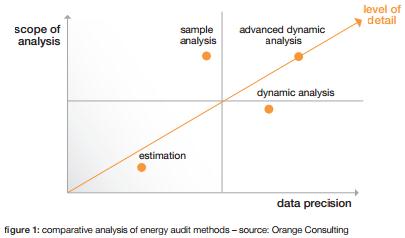Energy audits help IT managers and CSR departments improve their ability to monitor the volume, distribution and variation of energy consumed by IT equipment. Several different methods of auditing the energy consumption of your IT equipment are available to suit your specific goals:

1. estimation
- goal: to compile an initial comprehensive assessment of the energy used by IT equipment
- method: collect data using manufacturer specifications and then evaluate the global consumption of each equipment category
- tool: Excel spreadsheet
2. sample analysis
- goal: to provide a more precise estimation based on data collected from a representative sample of your IT equipment
- method: measure energy consumption of the sample based on operating data and then extrapolate the data for all IT equipment
- tool: Excel spreadsheet
3. dynamic analysis
- goal: to measure the energy consumption of your IT equipment over time
- method: use measurement software to collect data on energy consumption throughout the audit period and then analyze the energy profile
- tool: measurement software
4. advanced dynamic analysis
- goal: to provide a detailed assessment of your IT equipment’s energy consumption over time
- method: use measurement software to collect data on energy consumption throughout the audit period and then perform detailed analysis to compile comprehensive reports (volume, fluctuations, trends by equipment category)
- tools: measurement software and an Excel spreadsheet
Audits are used to compile a more or less detailed energy profile for your IT equipment in order to develop energy reduction scenarios. These scenarios will be featured in our next post!
To learn more about energy audits, I recommend the following white paper: Reducing the Energy Consumption of IT Equipment.
Laurence
This blog post was originally published in French here.
image © puckillustrations - Fotolia.com

I'm a Sustainable Development Expert Consultant at Orange Consulting, an affiliate of Orange Business. For the past five years I've worked with businesses on the risks and opportunities tied to IT and the environment, focusingon energy consumption and carbon emissions.